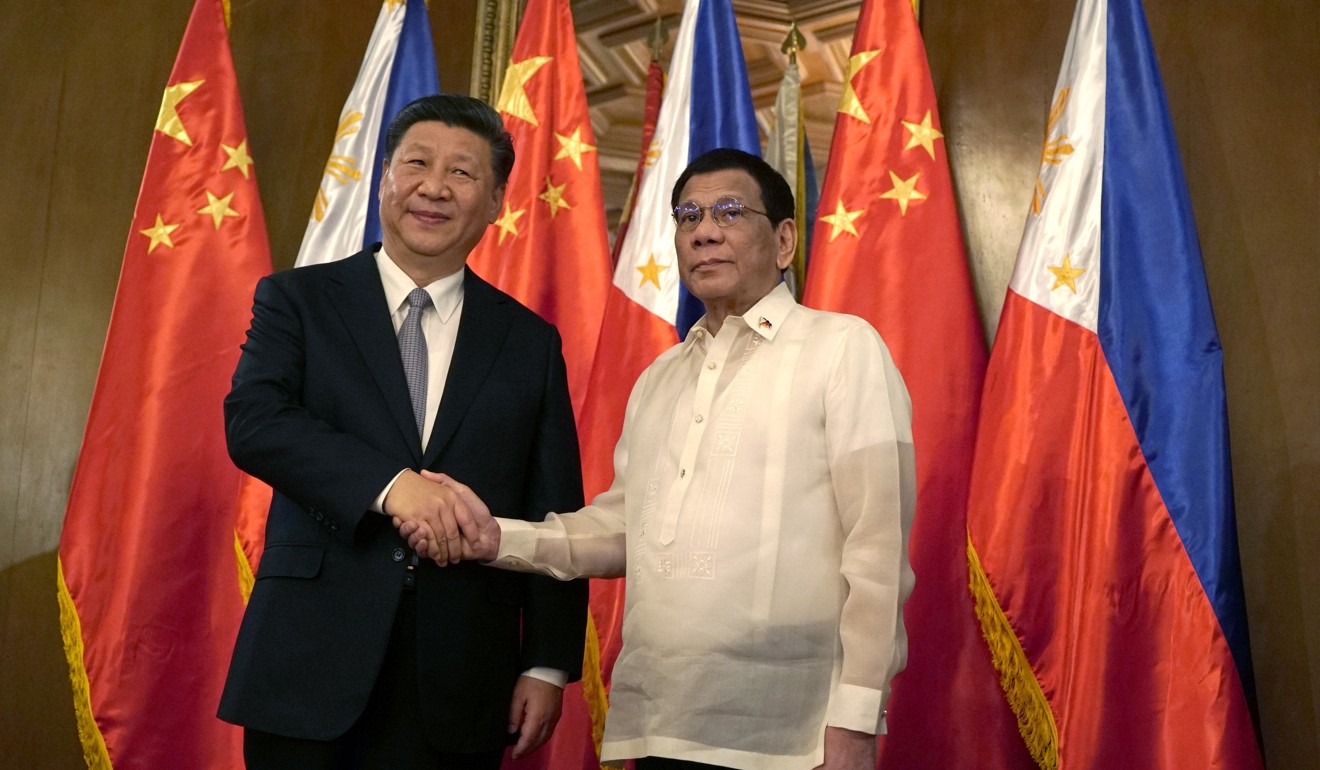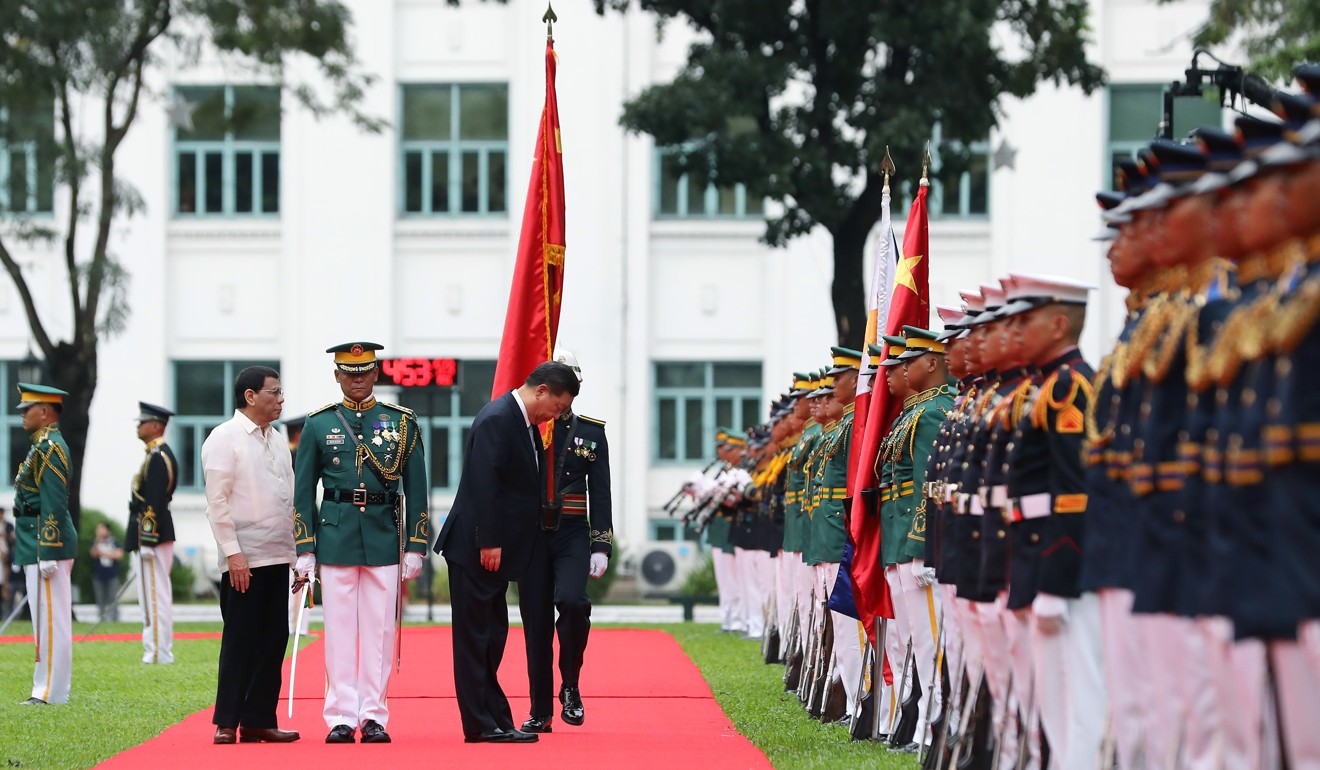
Picture imperfect: did Xi and Duterte agree to a ‘Blood Compact’ in Manila?
- The two presidents were photographed in front of a painting that, according to a historian, represents the start of Spain’s colonisation of the Philippines
When Philippine President Rodrigo Duterte posed for an official photograph with his Chinese counterpart Xi Jinping in the ceremonial hall of Malacanang Palace on Tuesday, their choice of a backdrop could hardly have been less auspicious.
The leaders, who witnessed the signing of 29 bilateral agreements during Xi’s two-day official visit to Manila were pictured in front of El Pacto de Sangre – or The Blood Compact – a 19th-century painting by internationally known artist Juan Luna that shows Spanish conquistador Miguel Lopez de Legazpi performing a traditional ritual of friendship with Datu Sikatuna, chieftain of the island of Bohol.
Filipino historian Xiao Chua, who teaches at De La Salle University, said: “Maybe someone in Malacanang was thinking this painting was a symbol that we are in good faith treating the Chinese government as a brother.”
China, Philippines aim for details of South China Sea oil exploration deal ‘within year’
But Chua, whose great-grandfather was a migrant from Fujian province in mainland China, said the scene actually represents “the start of our colonisation [by Spain]”.
The ceremony that is depicted reportedly involved the pair drinking from cups of wine into which the other had bled, took place in 1565. Known in the Visayan language as Sandugo, it symbolised the first treaty of friendship ever entered into between the Spaniards and native Filipinos.
The problem with this analogy is what happened after the Sandugo, Chua said.

“They (the Spaniards) did not know the significance of the blood compact to us. That’s why they colonised us. The Spaniards thought we were OK to be colonised.”
The painting is hung at the top of the stairs on the second floor of the palace, which is Duterte’s official residence and where he receives dignitaries. Guests would normally sign a guest book in front of the painting with ceremonies held in a hall down the corridor.
But Manolo Quezon, who served as former president Benigno Aquino III’s communications undersecretary, explained the choice of location for the photograph as being dictated by circumstances.
He said the area in front of the painting was chosen “as the ceremonial hall was closed off for preparations for the state dinner”.
Duterte’s Chinese adviser: proof of Beijing’s pull on Philippines?
Chua however, was more disturbed by what he described as protocol lapses during Xi’s visit, which began on Tuesday and ended on Wednesday.
He noted that the country’s Flag and Heraldic Code requires the Philippine flag to always be on the observer’s left-hand side, while that of the visiting country should be on the right. “Left is the place of prominence,” he points out.
Section 13 of the code states that “when displayed with another flag, the Philippine flag shall be on the right of the other flag”.
Yet during Xi’s visit, “in all the (pictures of) flags in Malacanang, China was always on the left,” Chua said.

Another break in protocol came during the honour guard ceremony marking Xi’s arrival at Malacanang. Protocol dictates that the Filipino soldier walking behind the two presidents should carry the presidential standard, Chua said.
In Xi’s case, however, the Chinese flag was carried.
Quezon on Wednesday also responded to discussions on social media by Filipinos on why there was a break in protocol.
If Duterte’s so proud of firing corrupt officials, why hire them?
On Twitter, he said: “Well the truthful reply to [these] ‘mistakes’ is as head of state/ultimate arbiter, no president ever breaks protocol, they make ‘exciting modifications’ or ‘dramatically dispense with protocol’. Which means if the president (or someone invoking him) orders it, subordinates comply.”
But Chua said he believed even the president needed to adhere to the Heraldic Code because it concerns official state symbols like the flag.
Last September, Philippine police cracked down on ordinary citizens who disrespected the country’s symbols by arresting 34 film-goers for violating the code by not standing up when the national anthem was played.

